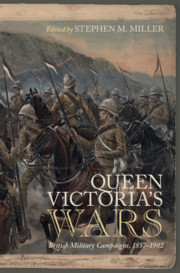Book contents
- Queen Victoria’s Wars
- Queen Victoria’s Wars
- Copyright page
- Contents
- Maps
- Contributors
- Acknowledgements
- 1 Introduction
- 2 The Indian Rebellion, 1857–1858
- 3 Punitive Expeditions in China, 1857–1860
- 4 The Expedition to Abyssinia, 1867–1868
- 5 The New Zealand Wars, 1845–1872
- 6 The Third Anglo-Asante War, 1873–1874
- 7 The Second Afghan War, 1878–1880
- 8 The Anglo-Zulu War, 1879
- 9 The First Anglo-Boer War, 1880–1881
- 10 Egypt and the Sudan, 1881–1885
- 11 The Third Anglo-Burmese War and the Pacification of Burma, 1885–1895
- 12 The Tirah Campaign, 1897–1898
- 13 Reconquest of the Sudan, 1896–1898
- 14 The South African War, 1899–1902
- 15 Conclusion
- Index
- References
6 - The Third Anglo-Asante War, 1873–1874
Published online by Cambridge University Press: 01 June 2021
- Queen Victoria’s Wars
- Queen Victoria’s Wars
- Copyright page
- Contents
- Maps
- Contributors
- Acknowledgements
- 1 Introduction
- 2 The Indian Rebellion, 1857–1858
- 3 Punitive Expeditions in China, 1857–1860
- 4 The Expedition to Abyssinia, 1867–1868
- 5 The New Zealand Wars, 1845–1872
- 6 The Third Anglo-Asante War, 1873–1874
- 7 The Second Afghan War, 1878–1880
- 8 The Anglo-Zulu War, 1879
- 9 The First Anglo-Boer War, 1880–1881
- 10 Egypt and the Sudan, 1881–1885
- 11 The Third Anglo-Burmese War and the Pacification of Burma, 1885–1895
- 12 The Tirah Campaign, 1897–1898
- 13 Reconquest of the Sudan, 1896–1898
- 14 The South African War, 1899–1902
- 15 Conclusion
- Index
- References
Summary
In 1873, Ashanti forces invaded the British Gold Coast Protectorate over a territorial dispute, inflicted serious harm on the Protectorate Fante population, and took hostage several European missionaries. A British force under General Sir Garnet Wolseley was dispatched, and in less than six months, defeated the Ashanti army and burned their capital of Kumasi. The hostages were freed and the Asantahene, Karikari, was forced to sign a harsh treaty. Wolseley employed a highly-mixed force and cadre of handpicked officers achieving great results. His force utilized advanced, and often untested, technology such as Martini-Henry rifles, light Armstrong cannons, Hale rockets, and telegraph lines which played significant roles in Wolseley’s military success, as well as Gatling guns and Steam Sappers (traction engines) which did not. Wolseley had to overcome engineering and biological obstacles: building 274 bridges while keeping disease under relative control. The Battle of Amoaful, fought on 31 January 1874, in which the British employed a square formation and marched straight into thick enemy-occupied bush, proved to be the decisive battle of the war. The success of the expedition opened up political, military, and public opinion to the notion that European armies could reliably operate in the West African interior.
- Type
- Chapter
- Information
- Queen Victoria's WarsBritish Military Campaigns, 1857–1902, pp. 106 - 125Publisher: Cambridge University PressPrint publication year: 2021



